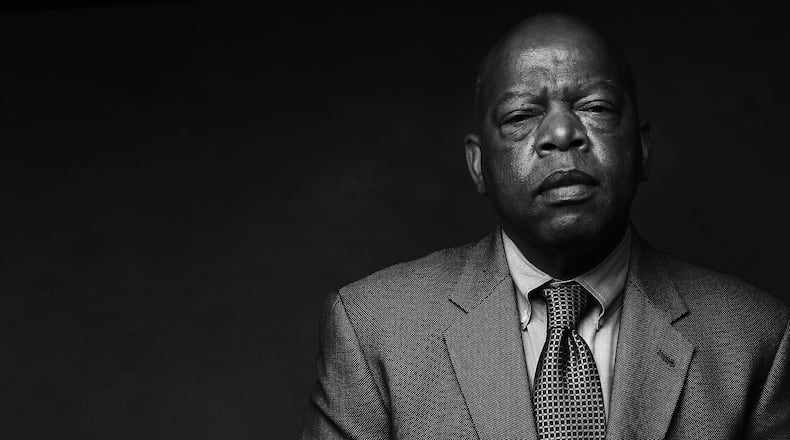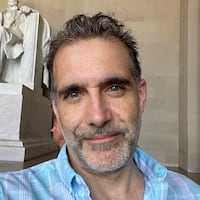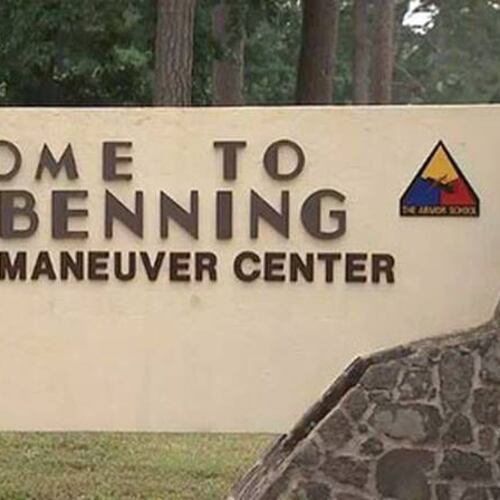U.S. Rep. John Lewis, the civil rights icon who practiced “good trouble” for more than 60 years, has died at the age of 80. Whether leading from outside the halls of power or from within, Lewis always listened to his heart and acted with a youthful brand of nonviolent civil disobedience. Here are moments from his amazing life.
John Lewis was born in 1940 to a family of sharecroppers in Troy, Alabama, and attended segregated schools. As a boy, Lewis would practice for a role in the clergy by preaching to chickens on his family's farm. He was inspired as a teenager to become an activist for desegregation after following the Montgomery Bus Boycott and hearing the Rev. Martin Luther King Jr.'s speeches.
John Lewis refers to his 45 arrests over the decades as "good trouble." He began organizing sit-in demonstrations at lunch counters while a student at American Baptist Theological Seminary in Nashville, Tennessee. (This mugshot is from the 1961 Freedom Rides when Lewis was sent to Parchman Penitentiary for using a "white" restroom.)
In 1961, Lewis became one of the original 13 Freedom Riders — a group of black and white activists who rode buses together across the South to challenge segregation in those states' bus terminals. The riders were often met with violence and arrests, including a vicious attack in Rock Hill, South Carolina, that left Lewis severely beaten. (A Klansman who attacked Lewis in Rock Hill would apologize to him in 2010.) Here, he is arrested in Jackson, Mississippi, with a bandage on his head.
Credit: PERRY AYCOCK
Credit: PERRY AYCOCK
On another occasion in Montgomery, Alabama, Lewis was knocked unconscious during an attack after the Riders arrived at the bus station. This photo shows Riders getting ready to board a bus from the Montgomery station under protection of the National Guard, several days after the attack.
In 1963, at the age of 23, Lewis became the third chairman of the Student Nonviolent Coordinating Committee, a young civil rights organization committed to nonviolent civil disobedience. In his memoir "Walking with the Wind," Lewis says that he hadn't sought the position: "I never really saw myself as a leader in the traditional sense of the word. I saw myself as a participator, an activist, a doer." His new role meant moving to Atlanta, where SNCC's national office was located.
A few months after becoming SNCC chairman, Lewis participated in the 1963 March on Washington and was that event's youngest speaker. He intended to deliver a fiery speech, but appeals from organizers Asa Philip Randolph and Bayard Rustin, as well as King, convinced him at the last minute to soften his language.
Credit: JIM BOURDIER
Credit: JIM BOURDIER
One of SNCC's signature accomplishments was the Mississippi Freedom Summer of 1964, a grassroots voter registration campaign that eventually created its own political party. Lewis was the public face of the student organization during this time, which experienced intimidation and violence, including the murders of three civil rights workers in Neshoba County. Two months before those murders, Lewis gave this press conference in Jackson, Mississippi, asking President Lyndon Johnson to protect the volunteers from harassment and violence.
Credit: AP file
Credit: AP file
SNCC represented the younger vanguard of the movement and Lewis was the youngest member of what was dubbed "the Big Six" (Lewis, King, Roy Wilkins, Randolph, James Farmer Jr. and Whitney Young Jr.). In this photo from 1965, Lewis and King (along with Andrew Young in back and Ralph David Abernathy at right) announce an economic boycott of Alabama. The next year, Lewis would be replaced by Stokely Carmichael, who took SNCC in a more militant direction.
Credit: AP file
Credit: AP file
In Alabama in 1965, John Lewis and Hosea Williams were to lead a group of marchers from Selma to Montgomery to bring attention to voting rights. Instead, the marchers were attacked by state troopers with batons and tear gas as the marchers descended the Edmund Pettus Bridge. Fifty-eight marchers were hospitalized in what became known as "Bloody Sunday," including Lewis (pictured here on the ground), who suffered a fractured skull. Lewis would later say that he expected to die that day. Media coverage of the attack made Lewis a household name and spurred support for the Voting Rights Act of 1965. As a congressman, Lewis returns to the bridge annually to commemorate the event.
Credit: Alyssa Pointer
Credit: Alyssa Pointer
Five months after Bloody Sunday, Lewis and Martin Luther King Jr. were guests of President Lyndon B. Johnson as he signed the 1965 Voting Rights Act into law. After the signing, Johnson gave Lewis a commemorative pen, which is now on display in a permanent art exhibit at Atlanta's Hartsfield Jackson International Airport.
Credit: Johnny Crawford
Credit: Johnny Crawford
Lewis married Lillian Miles in 1968 after meeting her at a New Year's Eve party hosted by Xernona Clayton. (They're seen here in 1988.) The politically active Lillian became Lewis' closest adviser and encouraged him to extend his civil rights work into politics in the 1970s. Lillian, an educator with an international perspective, was the director of external affairs in the Office of Research and Sponsored Programs at Clark Atlanta University. Lewis and Lillian had one child, John-Miles Lewis. They were married for 44 years until Lillian's death on Dec. 31, 2012.
Credit: Archie E. Allen
Credit: Archie E. Allen
After SNCC, Lewis worked for other civil rights groups, including a stint as associate director of the Field Foundation doing grassroots organizing, and as the director of the Voter Education Project from 1971-77. This photo from that period shows Lewis encouraging sugar cane workers in southern Louisiana to register and vote, during a VEP campaign to advance minority political participation in southern states.
Credit: Dwight Ross Jr.
Credit: Dwight Ross Jr.
John Lewis began his political career in 1977 with a defeat. Lewis saw his opportunity when President Jimmy Carter appointed Andrew Young as the U.S. ambassador to the United Nations, which forced Young to vacate his 5th Congressional District seat. In this photo, Lewis is joined at a campaign rally by his wife Lillian and son John-Miles, with Zell Miller in the background.
Credit: Dwight Ross Jr.
Credit: Dwight Ross Jr.
Lewis' plans to replace Young as congressman for the 5th District were foiled, however, by Wyche Fowler Jr., who defeated Lewis by 24 percentage points. Lewis said with a shrug after his loss, "I don't know what happened. ... I don't know." Carter would later appoint Lewis as associate director of ACTION, a federal volunteer agency.
Lewis had better luck in 1981 when he ran for Atlanta City Council. He won an at-large seat and served until 1986. He's seen here outside City Hall in 1982. Read here about his first year as a councilman.
Credit: Kenneth Walker
Credit: Kenneth Walker
In 1986, Lewis got a second chance to represent the 5th District when Wyche Fowler ran for the United States Senate. Lewis defeated Julian Bond, his friend and fellow civil rights icon, in a bitter primary contest. Lewis is seen here celebrating with supporters at his campaign headquarters on the night of his primary victory. Lewis would be reelected 16 times.
Credit: AJC Photo Archive at GSU Library
Credit: AJC Photo Archive at GSU Library
During Lewis' first term as a congressman, Atlanta was named as the host city for the 1988 Democratic National Convention, one of the largest events the city had hosted up to that time. Lewis, with Lillian by his side, delivered a speech on the last night of the convention.
Credit: Rick McKay
Credit: Rick McKay
During his more than 30 years in Congress, Lewis, seen here in 1992 in his Washington, D.C., office, has served on the Public Works Committee and on the Ways and Means Committee, where he has also acted as chairman of the Subcommittee on Oversight. His stances on civil and human rights earned him the nickname "the conscience of Congress" by his colleagues.
Credit: JOHN BAZEMORE
Credit: JOHN BAZEMORE
Lewis continued his protest activism while serving in Congress. (He's seen here leading a 1995 demonstration at a Medicare conference in Marietta.) Although he is known as a stalwart liberal Democrat, Lewis was in sharp disagreement with President Bill Clinton in the 1990s over welfare reform, the death penalty, military intervention and the NAFTA trade agreement.
Credit: Kimberly Smith
Credit: Kimberly Smith
Among his accomplishments in Congress, Lewis pushed for 15 years to create the National Museum of African American History and Culture. He also helped create the FBI's Cold Case Initiative, which reopens cases of racially motivated murders from past decades. And echoing his work in the civil rights movement, Lewis also led the fight to renew provisions in the Voting Rights Act of 1965. Here, Lewis shows off some of his civil rights memorabilia in his Atlanta office in 1994.
Credit: CHARLES KRUPA
Credit: CHARLES KRUPA
In 2001, Lewis was given the Profile in Courage Award for Lifetime Achievement by Caroline Kennedy in honor of his leadership during the civil rights movement in the 1960s.
In 2005, the city of Atlanta unveiled Thornton Dial's sculpture called "The Bridge," which depicts Lewis' march across the Edmund Pettus Bridge. The artwork, installed at Freedom Park, would be the first of several ways the city would honor Lewis.
Credit: LAUREN VICTORIA BURKE
Credit: LAUREN VICTORIA BURKE
Lewis is still committed to civil disobedience and has been arrested five times as a congressman. His "good trouble" résumé includes two arrests at the South African Embassy in Washington, D.C., to protest apartheid. He was also arrested in 2006 (pictured) and in 2009 for blocking the Sudanese Embassy over that country's genocide in Darfur. His most recent arrest was at an immigration reform protest on the National Mall in Washington in 2013.
Credit: LAUREN VICTORIA BURKE
Credit: LAUREN VICTORIA BURKE
In 2006, Lewis attended the groundbreaking of the MLK Memorial on the National Mall in Washington. Lewis became visibly emotional while holding a shovel at the ceremony. He told the AJC later that his thoughts took him back to the 1963 March on Washington and to King’s "I Have a Dream" speech. "It's unreal. It's so fitting and appropriate," Lewis said. "Out of all the people that spoke that day, I'm the only one who is still around."
Credit: John Spink
Credit: John Spink
During the 2008 Democratic presidential primary, Lewis campaigned for his friend Sen. Hillary Clinton (seen here at an Atlanta rally in late 2007). But after months of soul-searching, Lewis switched his endorsement to Sen. Barack Obama. Lewis explained that despite his loyalty to friends, Obama's campaign struck him as "a movement" and "a spiritual event" that he hadn't seen coming. "Sometimes, you have to be on the right side of history," he said. Lewis backed Clinton in 2016 in her primary fight with Sen. Bernie Sanders.
Credit: Carolyn Kaster
Credit: Carolyn Kaster
The decade of the 2010s saw Lewis receiving honors and lifetime achievement awards, including the Presidential Medal of Freedom, presented by President Barack Obama in an East Room ceremony in 2011. Obama said of Lewis, "Generations from now, when parents teach their children what is meant by courage, the story of John Lewis will come to mind — an American who knew that change could not wait for some other person or some other time; whose life is a lesson in the fierce urgency of now."
Credit: Jason Getz
Credit: Jason Getz
Lewis was honored again with the 2012 dedication of the colossal "HERO" mural in downtown Atlanta. The painting by Sean Schwab, at the corner of Jesse Hill Jr. Drive and Auburn Avenue, stands 65 feet tall and makes Lewis' face part of the city's skyline.
Credit: J. Scott Applewhite
Credit: J. Scott Applewhite
In 2013, Lewis became a comic book author with the publication of "MARCH: Book One," the first of a three-part autobiography of his time in the civil rights movement. Parts Two (pictured) and Three were published in 2015 and 2016, respectively. The graphic novels were co-written by Andrew Aydin and illustrated by Nate Powell. Among the trilogy's many awards, Part Three won a National Book Award for young people's literature.
Credit: Paramount Pictures
Credit: Paramount Pictures
In 2014, moviegoers saw the events on the Edmund Pettus Bridge dramatized in Ava DuVernay's film "Selma," which was partly filmed in Atlanta. Lewis was portrayed by Stephan James (center) and said the film moved him to tears. Lewis' trench coat and backpack from that day in 1965 became a "costume" that he — and fans — wore to comic book conventions.
Credit: Jacquelyn Martin
Credit: Jacquelyn Martin
Lewis returns every year to Selma to walk across the Edmund Pettus Bridge. In 2015, he commemorated the 50th anniversary of Bloody Sunday by joining hands with President Barack Obama and his family and leading a march. Other survivors of Bloody Sunday helped lead the procession. The event included a rare joint appearance by Obama and President George W. Bush.
Credit: Rep. John Yarmuth
Credit: Rep. John Yarmuth
In 2016, Lewis led another sit-in in an unlikely place — the floor of the U.S. House of Representatives. The day-long protest was launched by a handful of Democrats trying to force a vote on gun control measures. Eventually 170 lawmakers participated in the protest. House Speaker Paul Ryan, who called the effort a publicity stunt, chose not to have the lawmakers forcibly removed or arrested.
Credit: Manuel Balce Ceneta
Credit: Manuel Balce Ceneta
Lewis was the star speaker at the opening ceremony of the Smithsonian National Museum of African American History and Culture on the National Mall in Washington in 2016. Lewis worked for 15 years to get funding from Congress for the museum. During his speech, he said, "This museum is a testament to the dignity of the dispossessed in every corner of the globe who yearn for freedom. It is a song to the scholars and scribes, scientists and teachers, to the revolutionaries and voices of protest, to the ministers and the authors of peace."
Credit: AL DRAGO
Credit: AL DRAGO
Lewis began 2017 by getting into a public feud with President-elect Donald Trump on the eve of Trump's inauguration. The fight began when Lewis said on "Meet the Press" that he didn't consider Trump a "legitimate president" and said he would be boycotting the inauguration. (Lewis previously boycotted the 2001 swearing-in of George W. Bush.) Trump responded by tweeting, "Congressman John Lewis should spend more time on fixing and helping his district, which is in horrible shape and falling apart (not to mention crime infested) rather than falsely complaining about the election results. All talk, talk, talk -- no action or results. Sad!"
Credit: Alyssa Pointer
Credit: Alyssa Pointer
In 2018, Lewis received two more tributes from the city of Atlanta. First, Hartsfield-Jackson International Airport unveiled an exhibit dedicated to Lewis in its domestic terminal atrium. The wall of art, called "John Lewis — Good Trouble," includes artifacts, photos and video from Lewis' years in the civil rights movement.
Credit: Bob Andres
Credit: Bob Andres
In another tribute that year, Freedom Parkway was renamed "John Lewis Freedom Parkway." The dedication, led by Mayor Keisha Lance Bottoms, included the unveiling of a play space near the existing Thornton Dial sculpture, "The Bridge."
Credit: ALYSSA SCHUKAR
Credit: ALYSSA SCHUKAR
Lewis announced on Dec. 29, 2019, that he has Stage IV pancreatic cancer. “It is a challenge and a fight,” he told The Atlanta Journal-Constitution. “But I have had challenges before and been fighting all my life. I am ready for the fight. I will go through the treatment and face the day each day like it is a new day. I will continue to be hopeful and optimistic.”
Rep. John Lewis died on the evening of July 17, 2020.
About the Author
Keep Reading
The Latest
Featured







































